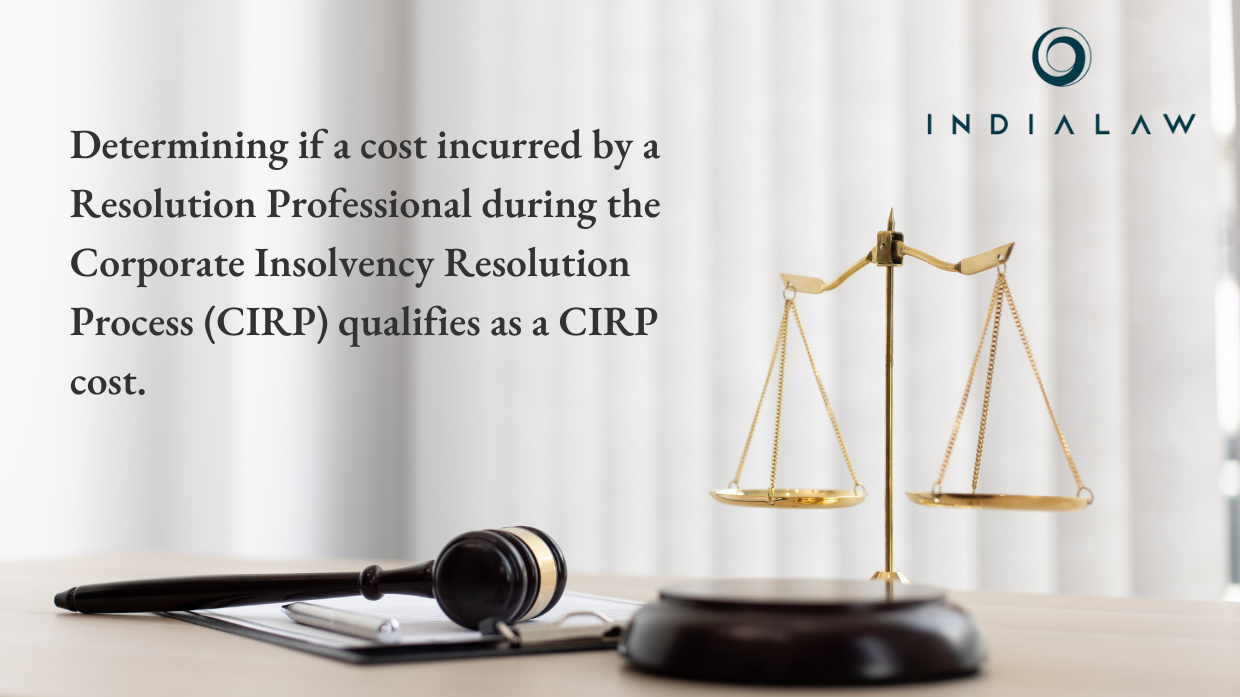Whether A Cost Incurred By Resolution Professional During CIRP Qualifies as CIRP Cost?

Introduction
In a recent ruling dated 14.05.2024, in the case of Avil Menezes (Liquidator) v. Abdul Qudduskhan and Anr,[i] the Hon’ble NCLAT, New Delhi, clarified that the mere fact that dues have arisen during the Corporate Insolvency Resolution Process (CIRP) period is not sufficient to classify them as CIRP costs.
Table of Contents
Facts of the Case
The Appellant, appointed as the Liquidator of the Corporate Debtor, initiated the process of inviting claims from all creditors. The Respondent No.1/subcontractor submitted a claim amounting to Rs. 1,36,41,854/- for fabrication and erection work at the Project site. The Appellant determined that this claim did not qualify as a CIRP cost. Respondent No.1 contested this determination, demanding immediate payment and asserting that the dues constituted CIRP costs. The Appellant reiterated that the claim did not meet the criteria for CIRP costs and would be processed under section 53 of the Insolvency and Bankruptcy Code (IBC).
Subsequently, Respondent No.1 filed an Application seeking directions from the Hon’ble NCLT to classify its claim as a CIRP cost. The Hon’ble NCLT directed the Appellant to process the claim on its merits. After review, the Appellant maintained that the claim did not qualify as a CIRP cost, referencing the decision of the coc and other relevant provisions of the Code. Aggrieved, Respondent No.1 filed another Interlocutory Application seeking to have its claim classified as a CIRP cost. The Hon’ble NCLT then directed the Appellant to admit Respondent No.1’s dues as CIRP costs. Consequently, the present appeal was filed by the Appellant.
Contentions of Both Parties
The Appellant argued that the Impugned Order incorrectly determined that Respondent No.1’s dues must be classified as CIRP costs and that the said interpretation is contrary to (a) the decision of the coc, (b) the interpretation of CIRP costs under the Insolvency and Bankruptcy Code and Regulation 31 of the CIRP Regulations, and (c) the payment terms stipulated in the contract dated 27.02.2018. The Appellant further submitted that in similar applications within the same Company Petition, the Hon’ble NCLT had ruled that dues could only be classified as CIRP costs if confirmed by the coc during the CIRP period. The Appellant contended that the NCLT is bound by the doctrines of stare decisis and res judicata, which mandate adherence to previous rulings and prevent re-litigation of the same issue.
The Appellant contended that the criteria for classifying costs as CIRP costs are as follows: (a) the costs must be incurred by the Resolution Professional during the CIRP period to keep the Corporate Debtor a going concern, (b) the costs must be towards suppliers of essential goods and services, and (c) the costs must be directly related to the CIRP and approved by the Committee of Creditors (coc).
The Respondent contended that the Liquidator has not adequately reviewed the available records, which demonstrate that the Respondent performed the work during the Corporate Insolvency Resolution Process (CIRP) of the Corporate Debtor. Additionally, it was claimed that the invoices issued by the Respondent were endorsed by the Corporate Debtor under the direction and supervision of the Resolution Professional.
As per Regulation 17 of the IBBI Liquidation Process Regulations, the Liquidator is obligated to assess and either accept or reject claims based on the evidence submitted. Given these arguments, Respondent No. 1 argued that the impugned order requires no further examination and prayed that the matter that be disposed of accordingly.
Decision of the NCLAT
The Hon’ble NCLAT formulated one significant issue regarding whether the costs accrued for the activities undertaken during the CIRP by Respondent No 1 can be considered as CIRP Cost or not by the Liquidator.
The Appellate Tribunal determined that the decision made during the coc meetings indicated that payments to vendors for specific projects were to be funded from the projects’ own cash flow. Since the Darlipali Plant of the Corporate Debtor ceased operations during the CIRP Period, the activities of Respondent No. 1, acting as a subcontractor, didn’t contribute to the Corporate Debtor’s viability as a “going concern.” Hence, Respondent No. 2, as the Resolution Professional, excluded the costs incurred by Respondent No. 1 from being considered as CIRP Costs.
The Appellate Tribunal noted that costs could be considered CIRP costs only if they were directly associated with the CIRP and if approved by the coc. It highlighted that in this instance, the coc had not approved the costs as CIRP costs.
The NCLAT referenced Circular No. IBBI/IP013/2018 dated 12.06.2018, which guides insolvency professionals to ensure that fees and expenses incurred are directly related to and necessary for the CIRP, with approval from the coc when required. It clarifies that the Insolvency Resolution Professional Cost (IRPC) should not include any expenses not directly linked to the CIRP. In light of this guidance, the NCLAT found merit in the actions taken by both the erstwhile Resolution Professional and the Appellant concerning the claims of the subcontractor.
The Hon’ble NCLAT placed reliance on the case of Bharat Hotels Ltd. V Tapan Chakraborty Company Appeal (AT) (Insolvency) No. 1074 of 2022 wherein it was held that “…Question of cost and its approval lays in the domain of the coc. The coc may ratify, modify or set aside the cost claimed. These issued may be decided in the meeting of the coc and are not to be examined by the Adjudicating Authority even before the coc takes a decision.”
This position was also reiterated in Mehul Parekh and Ors. V. Unimark Remedies and Ors. Company Appeal (AT) (Ins) No. 839 of 2023 where it has been noted that “…The direction to coc to redetermine the CIRP cost after approval of the Resolution Plan by the coc is unsustainable”
Accordingly, the Hon’ble NCLAT held that mere occurrence of dues during the CIRP period does not automatically warrant their classification as CIRP costs. Such an interpretation of Section 5(13)(c) of the Code would render the phrase “in running the business of the corporate debtor as a going concern” meaningless.
Conclusion
In summary, for a cost incurred by the Resolution Professional during CIRP to qualify as a CIRP cost, it must meet specific criteria, including maintaining the Corporate Debtor as a going concern, payment to suppliers of essential goods and services, and direct relation to CIRP with approval from the coc. Applying these criteria to the case at hand, it became apparent that the Respondent’s claim did not align with the definition of a CIRP cost. The absence of coc approval, failure to support the Corporate Debtor’s “going concern” status, and reliance on unrealized payments from NTPC were key factors in this determination. Consequently, the Respondent’s claim should be categorized as a non-CIRP cost under Section 53 of the Code for distribution during liquidation. The Tribunal overturned the decision of the Adjudicating Authority, citing its contradiction with coc authority, past precedents, and commercial realities.
[i] (2024) ibclaw.in 320 NCLAT
By entering the email address you agree to our Privacy Policy.



